Text
Kavyalakshmi Suresh’s graduation collection inspired by the Eszterháza Palace is a Pastel Dream!
This article begins a series of articles featuring fashion / design graduation projects by creatives from all over! Providing a deeper look into the design process and work that goes behind a design project, through this series we hope to not only promote fresh talent, but also make fashion and design accessible to all, all while providing an interesting reading experience for everyone and anyone! -If you are interested in being featured, Please send us a DM on our Instagram page @capdah_ -
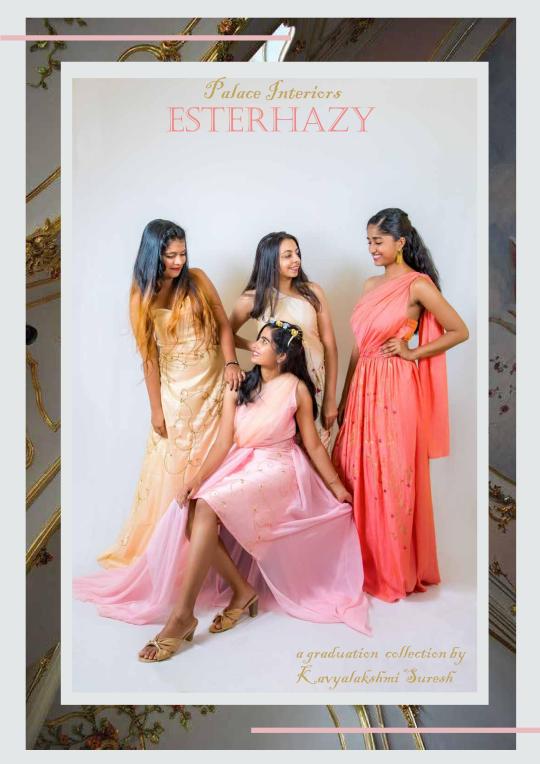
A recent fashion design graduate from Manipal Academy of Higher Education, Kavyalakshmi Suresh is a fashion creative hailing from Tamil Nadu, India. For her graduation collection, She seeks inspiration from the interiors of the Esterhazy Palace located at Fertőd, Hungary, built by Prince Nikolaus Esterházy.
A fine example of rococo-style palaces, The Eszterháza (as it is more popularly called) is one of the many palaces with the namesake, Esterhazy and is not to be confused with the Schloss Esterhazy in Austria, belonging to the same Hungarian noble family, Esterhazy.

One of the most noticeable features of the palace interiors is the exquisite ornamental Rococo style consisting of soft pastel colors, scrolling curves, gilding, sculpted molding, twisting vines, and illusionist ceiling paintings which were designed to give the impression that those entering the room were looking up at the sky, where cherubs and other figures were gazing down at them.
In Kavyalakshmi’s own words, she was inspired by these very elegant and very whimsical elements of the Palace in designing and setting the mood for her collection, which consists of Pastel and blush tones, exquisite embroidery, Hand-painted golden vines, draped silhouettes and fabric manipulation.
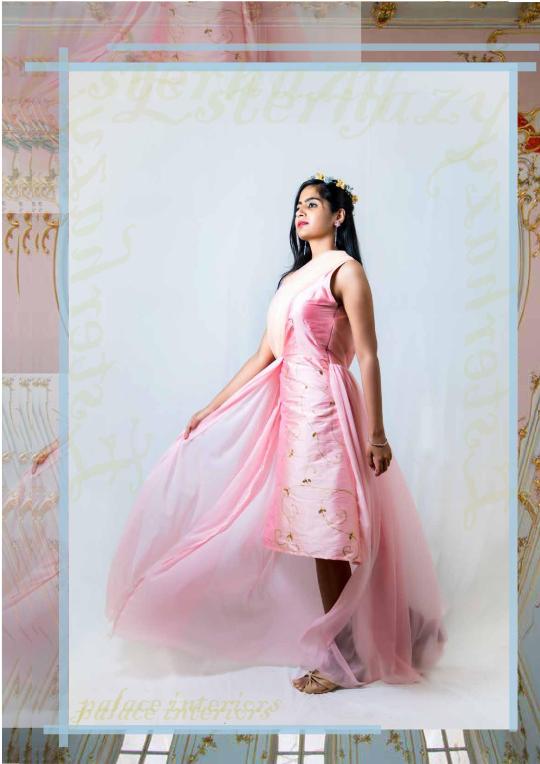
Featuring delicate angelic gowns intended as Bridesmaids gowns, the collection features flowy and flared silhouettes, pleating and gathering, in fabrics such as pearl-embellished net, silk-cotton, and georgette.
Another striking point of the collection are the necklines. Consisting of asymmetric necklines with one-shoulder pleats, the classic sweet-heart and one-shoulder necklines, the collection exudes fairy-tale like-charm and elegance while also capturing elements of Rococo such as asymmetry, and the illusion of motion and drama.
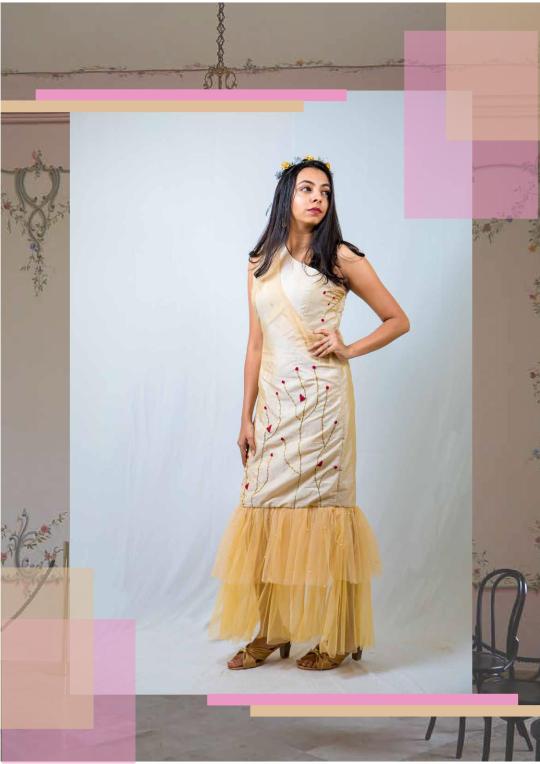
Incorporating hand-painted golden vines reminiscent of the gilded rococo-esque vines decorating the palace, other surface ornamentation techniques in the form of Ribbon embroidery and delicately embroidered flowers and leaves also adorn the garments, incorporating classic stitches such as French-knots, fishbone, stem and chain stitches.
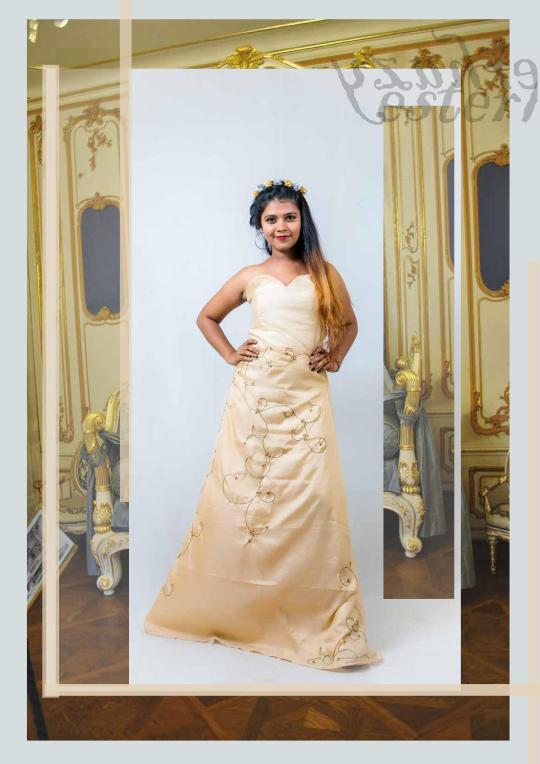
Entirely researched, conceptualized, stitched, hand-embroidered and hand-painted by the designer, the pain-staking effort is clearly reflected in the exquisite yet minimalistic garments.
Seeming simple without being boring, the collection exudes the right amount of whimsical ball-room drama, the cuts, flowy nets and drapes being testimony of this, wonderfully executed by the designer.
Asked about her future goals, Kavyalakshmi opens up about looking for the right job suited to her sense of aesthetics and design. Deeply interested in making and creating, She is also a co-owner and maker of a handcrafted accessories, decor and clothing online store, ‘Anerin’.
The designs featured here are completely and totally designed and executed by Kavyalakshmi Suresh. No part of the work featured here may be copied or plagiarized in any manner. None of the images and content featured here may be used for any purpose, commercial or otherwise, without prior consent of the designer.
This article has been written with prior consent and insights from the designer. Also a dance, embroidery and hairstyling enthusiast, She can be contacted at:
LinkedIn
Aneirin
Email: [email protected]
CREDITS:
Design, Styling and hair: Kavyalakshmi Suresh
Photographed by: Mohan Raj photography
Modelled by: Jenesha D’sa, Rutaja Kulkarni ,Zainab and Jennifer.
Layout and editing: Asmitha Shenoy/ Capdah.
#fashion#fashiondesigner#fashion student#fashion collection#haute couture#gowns#fashiongowns#designer#designer clothing#designerclothes#fashion graduate#fashionportfolio#fashion photography#esterhazy#rococco#rococó#baroque#palace of versailles#palaces#hungary#fashionblog#fashionblogpost#fashionblogger#fashionblogdaily#fashionblogstyle#fashion inspiration#europeanart#europe aesthetic#bridesmaids#fairytalewedding
8 notes
·
View notes
Text
Sustainability in Fashion & the P-word

If one buzz word has been making the rounds lately (and rightfully so!) in the fashion industry and beyond, it’s sustainability.
With the fashion industry being one of the world’s MOST polluting industries, it’s about time fashion started to clean up it’s act. One of the most infamous words in fashion then, would be plastic, or even polyester ( one of the most common synthetic fibres derived from plastic- but ok- that’s two P words, then!)
As we, as consumers, have been growing more aware than ever about what goes into our clothes (and often, who made my clothes), most of us probably have a gist of what makes plastic-based synthetic fabrics so terrible in the first place.
Synthetic fibres like polyester are not biodegradeable, and end up filling landfills and polluting our oceans ( which also means a major threat to aquatic life) practically...forever.
As fast fashion (aka a huge chunk of where most of the population fulfills it’s clothing needs from) relies heavily on these synthetic-based fabrics that are inexpensive to make, and estimated 65 million tonnes of these plastic-based materials are generated every year.
With these facts before us, as consumers, do we have alternatives to this?
We could just buy less, or not at all, unless we really need it. Making the most of clothing already in our closets. Swapping clothes, thrifting/buying vintage. Choosing more sustainable brands, brands that offer durable clothing. (Beware of green-washing, this would take some personal efforts to research on a brand).
But getting back to plastics. We know that they aren’t biodegradeable, so what happens to the estimated 8 billion tonnes of plastic that already exists on the planet?
Well, the bad news is, we just can’t get rid of it.
While some countries have resorted to burning it, that just creates carbon emissions ( as plastic is made out of fossil fuels), only adding to the issue of climate change.
Some brands have tried to solve the plastic problem by incorporating recycled plastic into their clothing. As the industry still relies on synthetics largely due to it’s versatility (such as stretchability for one, especially in active wear,lingerie and swim wear), it’s still hard to avoid synthetics completely. Using recycled plastic serves as an attractive option that is not only effective in keeping plastic out of landfills, but also acts as an alternative to virgin plastic.
However, this has it’s limitations: When the final consumer is done with the garment, it is still likely to end up in the landfill. Another issue, is that washing synthetic materials leads to the release of minuscule pieces of plastic into the water, which eventually finds it’s way into the ocean.
Biologists have also found traces of these microplastics inside fish, which means they have entered the human food chain.
Brands such as Reformation, have been trying to develop measures to raise awareness on this issue and control it, by offering tips on reducing the shed of microplastics to their consumers, such as gently washing synthetic garments by hand in cold water ( Which releases fewer particles as compared to a machine wash).
Though brands have been incorporating recycled plastics from, say, industrial plastics or PET bottles, we still do not have the technological capabilities yet, to recycle plastic-based fibres. As synthetic fabrics are a blend of different fibres,it is harder to break them down as compared to fabrics made of a single fibre.
As scientists are currently developing technology to seperate different fibres in a blend, and turn them back into new fibres ( which can be used for new clothing),it could lead to the development of a perfectly circular system, potentially transforming the entire fashion industry as we know it.
As synthetics can be infintely recycled, one hopes for a time where we do away with manufacturing plastic altogether.
As for the staggering amount of plastic ( which we still do not have a sustainable method of disposing), we will perhaps, have to live with it. Let us live with it then, as mindfully as possible.
As we face the consequences
and science hopefully comes up with a cure,
one thing is for sure:
Life in Plastic, really ain’t fantastic.
( This article was heavily referenced from this article by Fast company.com . Do read it for more insights, especially pertaining to synthetics in the swimwear industry.
This article takes a look at the harmful effects of plastic from an often-neglected angle: Our skin and health.)
#fashion#fashionblogpost#fashionblogdaily#fashionblogger#sustainability#sustainablefashion#sustainable#barbie#plastic#indianfashion#fashiondesign#fabric#textile#issue#climate change#thrifting#thrift#fashionblogstyle#ootd#style#trendfashion#trendsetter#trendmodel#trendyoutfits#trendy#zaralook#shein#hm
0 notes
Photo
G-O-R-G-E-O-U-S!
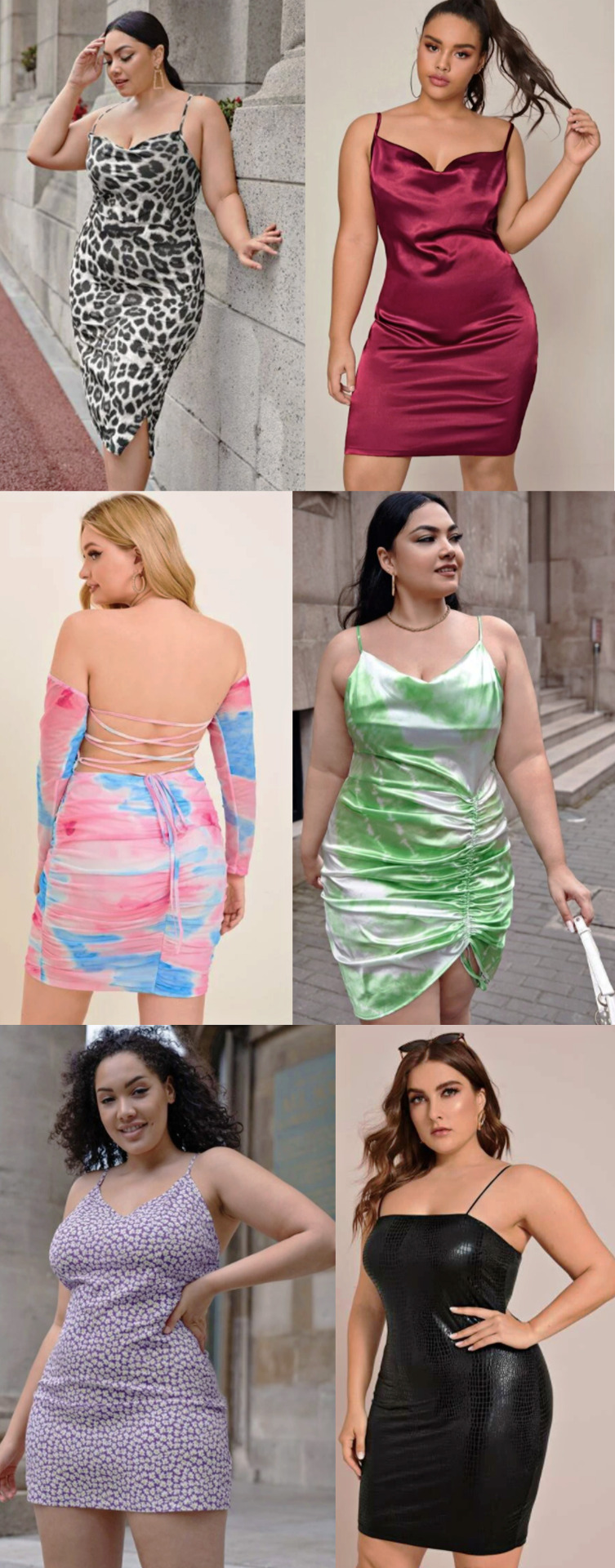
✨ ⭐ plus pretty dresses $6 - $12 ~~ 00A // 00B // 00C // 00D // 00E // 00F
34 notes
·
View notes
Text
Fashion archival: Indian Fashion in the early to mid 2000s (Magazine scans)
The indian fashion scene as we know it today rose to what it is due to rapid changes in the 80s and 90s, with the first generation of fashion designers such as Satya Paul, Ritu Kumar (One of India’s earliest designers--beginning her career as early as the 60s!) and others, and the ministry of textiles establishing the National Institute of Fashion Technology.
The 90s saw the birth of iconic fashion staples (such as the kurti by Monisha Jaising, Manish Malhotra’s ‘cocktail sari’ and bollywood glamour) propelled by these fresh breed of designers, and also saw the birth of the Fashion Design Council of India (which was instrumental in launching fashion weeks in the country). This was largely due to the liberalisation of the Indian economy in the 90s. As Indian fashion has carved a niche for itself in the global fashion industry, it’s really interesting to take a look back at some of the fashion magazine pages from the early to mid 2000s. (Especially with the y2k trend/ fascination with 2000s fashion still going strong!)
These photos have been sourced from past issues of two iconic Indian magazines, ‘Women’s era’ and ‘Femina’.




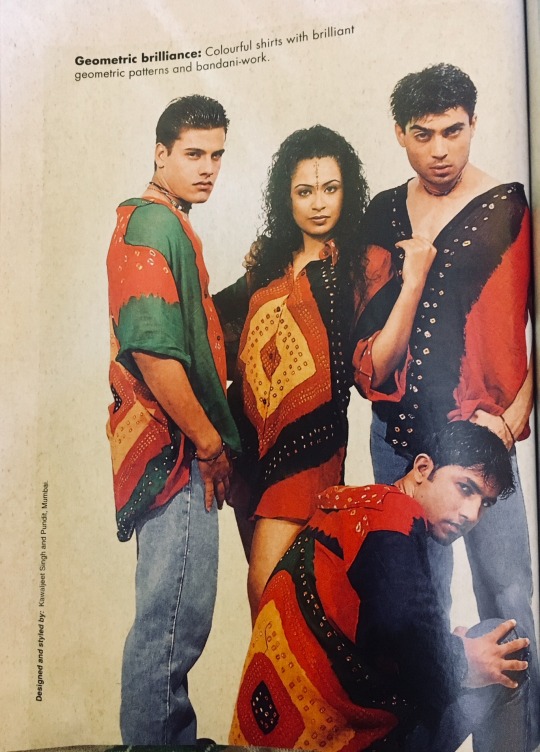




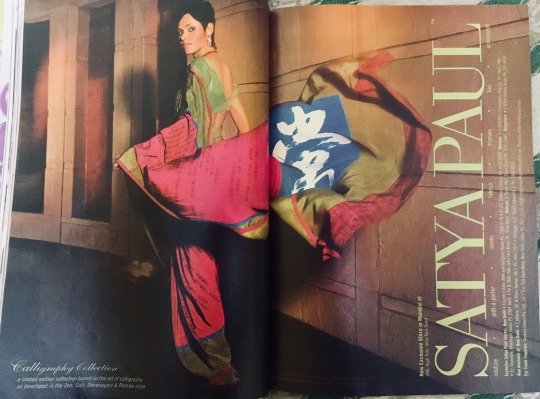
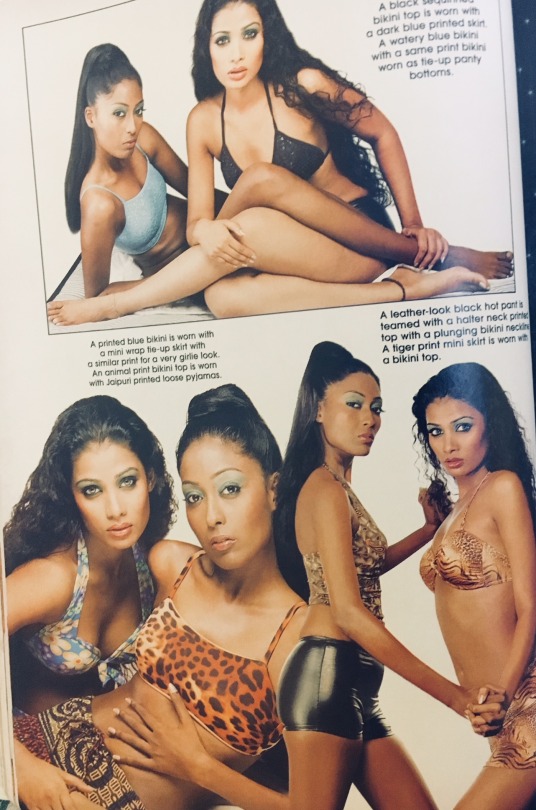
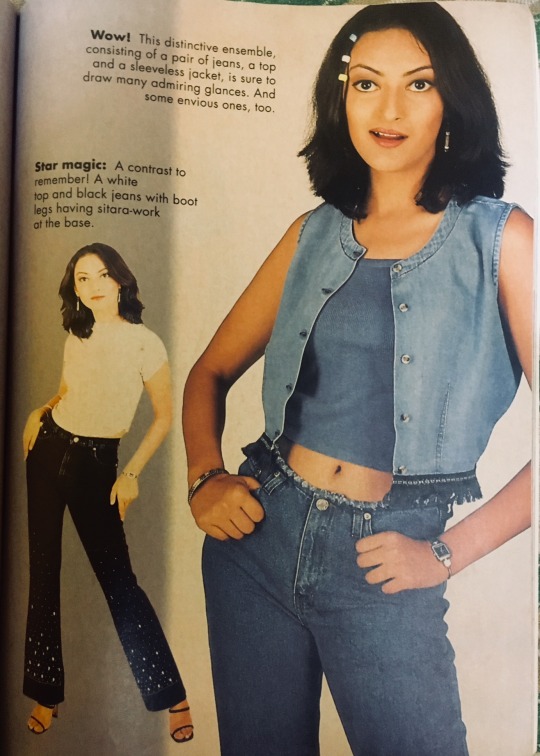

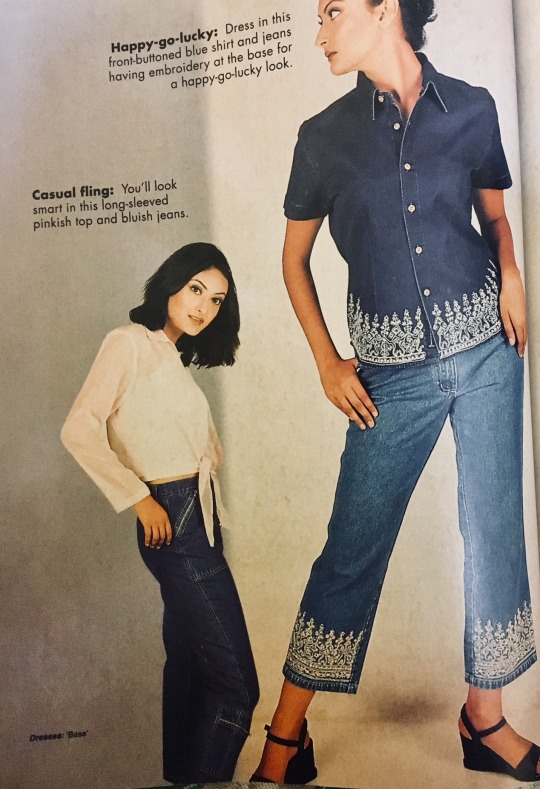




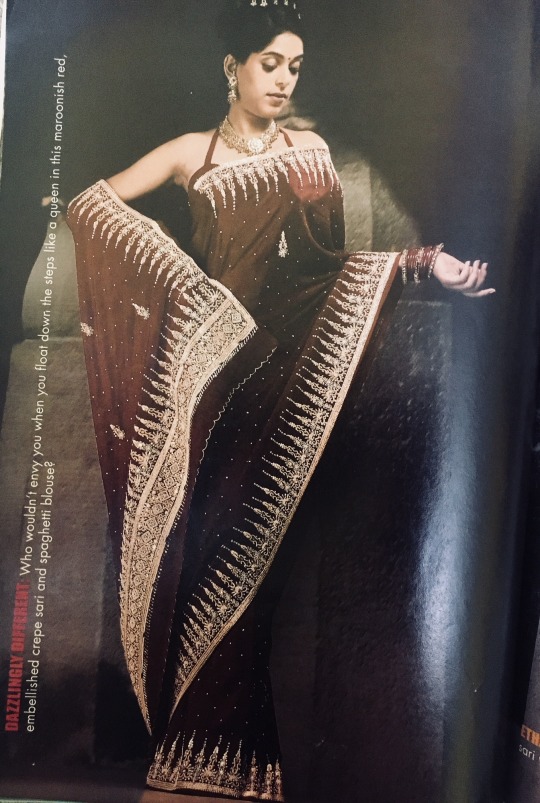







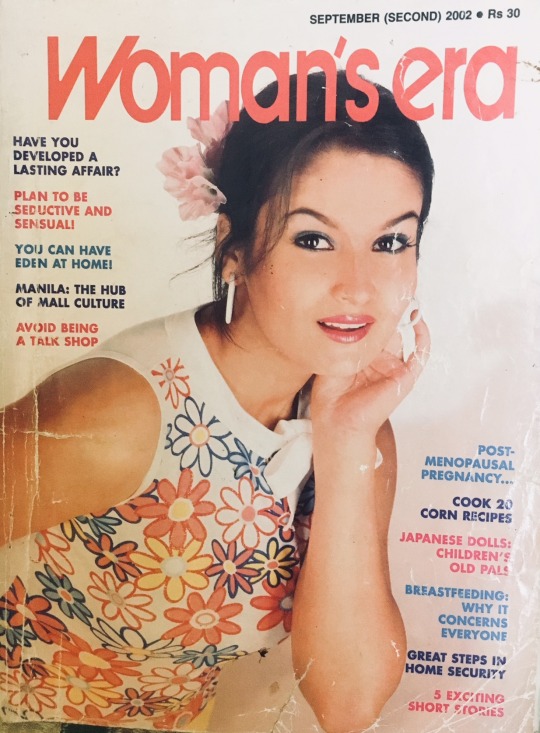




#fashion#fashionblog#fashionblogdaily#fashionblogger#indianfashion#indianfashionblog#anitadongre#ravibajaj#satya paul#fdci#indianstreetstyle#sari#fashion history#fashion archive#y2kcore#y2k fashion#fashion magazine#2000s nostalgia#southasianfashion#bollywoodfashion#style#styleinspiration#styleinspo#fashiondesigner#fashiondesign
6 notes
·
View notes
Text
Fashion Archival: Vintage Bathing suits from the 1960s
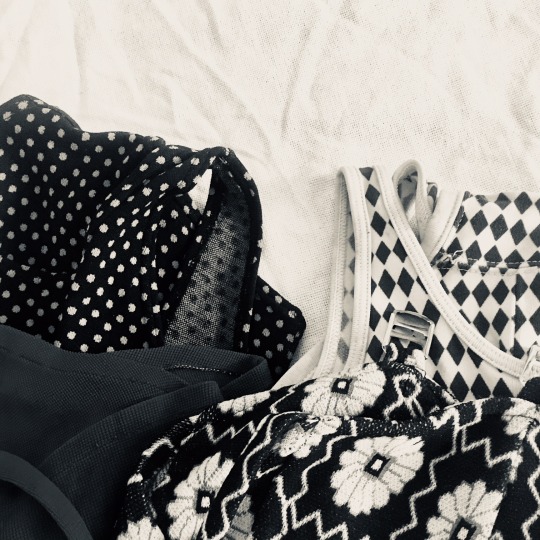
Featuring a small collection of young girls’ bathing suits from the 1960s!
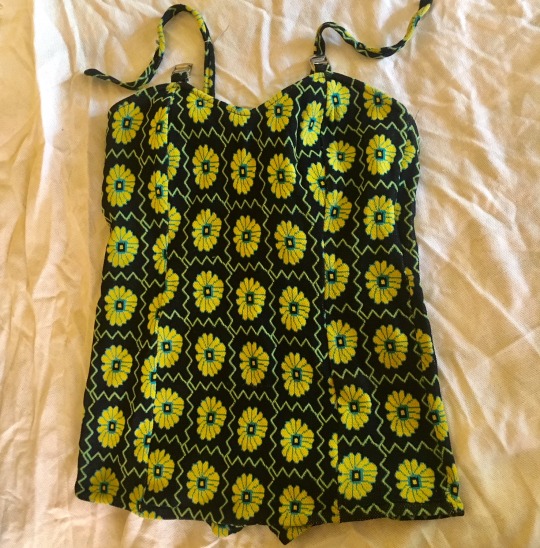
Beginning with this gorgeous one-piece with shoulder-strap fastenings, the knits used back then seem to be thicker than the ones used in swimsuits today and have a more ‘knitted’ feel to them. This one comes with a pretty sweet-heart neckline and cheerful yellow sunflower-print over a black backdrop and squigly lines.
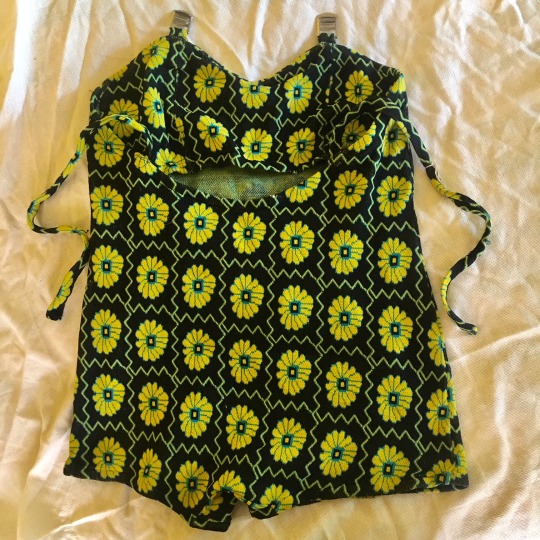
With a deep-U back, and a shorts-style pattern, this cute number screams retro-chic!
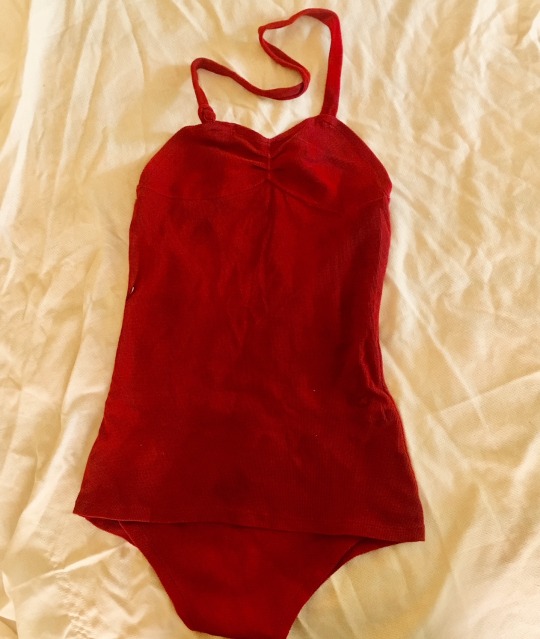
This solid red halter-neck bathing suit is classic, minimal and elegant. Also featuring a sweet-heart neckline, and an apron/skirt style at the front, the little rushed-detail at the center front is just like the cherry on top in this cherry-red one-piece!

The back features a classic one-piece swimsuit pattern with a curvy V-shaped back.
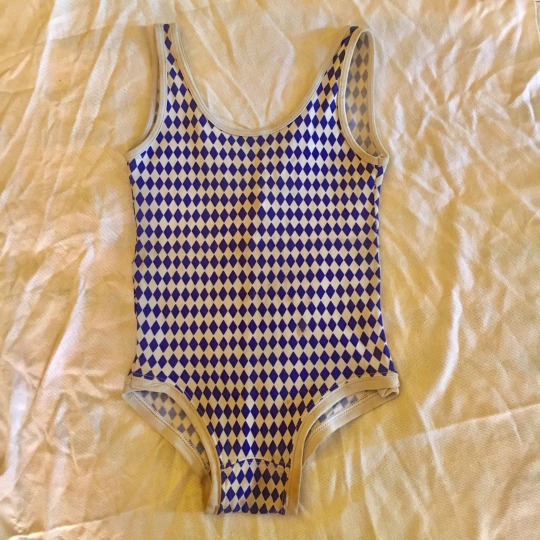
This geometric-patterned swimsuit in a classic one-piece pattern features a slightly thinner fabric than the others and a more ‘synthetic’ appearance.
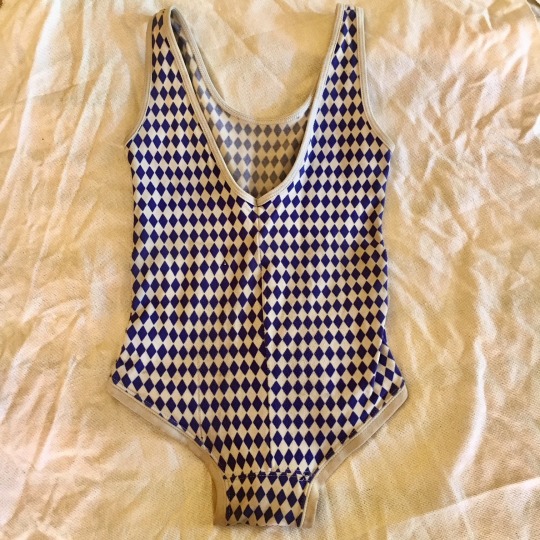
The print screams “Mod fashion!” and is classic 60s.

Finally ending with this cute polka-dotted bathing suit!
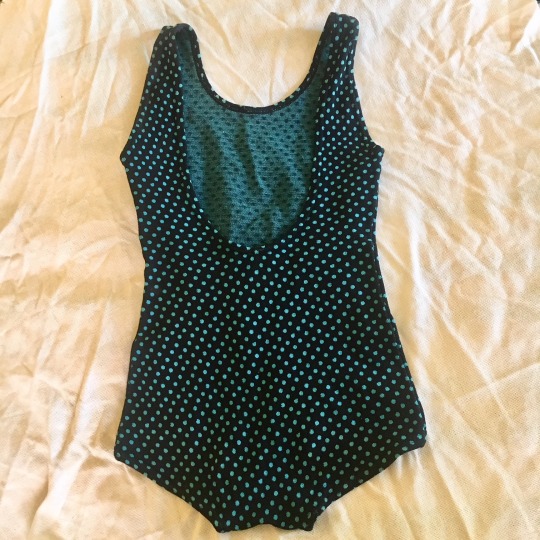
...and the back! It has a narrow-U shaped back and cut wider at the bottom.
Which one was your favourite? Would you have anything to add? Let’s talk retro swimsuits! (In the comments below, of course!)
#fashion#fashion inspiration#retro aesthetic#retro fashion#vintage fashion#sustainable fashion#thrifstorefinds#fashion history#1960s fashion#60s vintage#60s fashion#mod fashion#fashion design#fashion blog#fashion blogger#fashionblogpost#fashionblogstyle
0 notes
Text
Favorite looks from Lakme Fashion week 2020- DAY 1
If you’re an avid follower of fashion and Indian fashion in particular, You’d probably be in-the-know of the fact that it’s fashion week season in India.
With the 5-day long Lakme Fashion week 2020 ( Which began from October 21 until oct 25) winding up today, I decided to sit down and decode some of my top collections and looks from the shows, Beginning with day 1, so here we go!

(Above: ‘Ruhaaniyat’, Manish Malhotra)
The fashion week was opened by designer Manish Malhotra with his collection entitled ‘Ruhaaniyat’ which was a tribute to the craftsmen and artisans of India, in association with the Mijwan foundation with whom the designer has been collaborating for the past 10 years.
Drawing inspiration from the beautiful regions of Punjab, Awadh and Kutch, the collection featured embellished fabrics with intricate zari, Chikan and zardozi work.
Featuring gorgeous layered silhouettes oozing with royal opulence and a quaint old-world charm, the ensemble pictured above, was definitely a personal favorite. From the beautiful trail of the ghararas to the color palette of electric blue and an earthy sand brown, the ensembles were perfectly accentuated with the beautiful gold-and-diamond jewelry, featuring maang tikas,chokers, haathphool kadas and rings to name a few. Mesmerizing!
Day 1 of the digital fashion week was dedicated to Sustainable fashion. This was perfectly embodied in the circular design challenge-winning collection, ‘Malai’ by Susmith Chempodil and Zuzana Gombosova.

(above: Malai )
The collection incorporates bio-composite material, based on Bacterial Cellulose grown on water from mature coconuts and natural fibres, as an alternative to leather for fashionable accessories and garments.
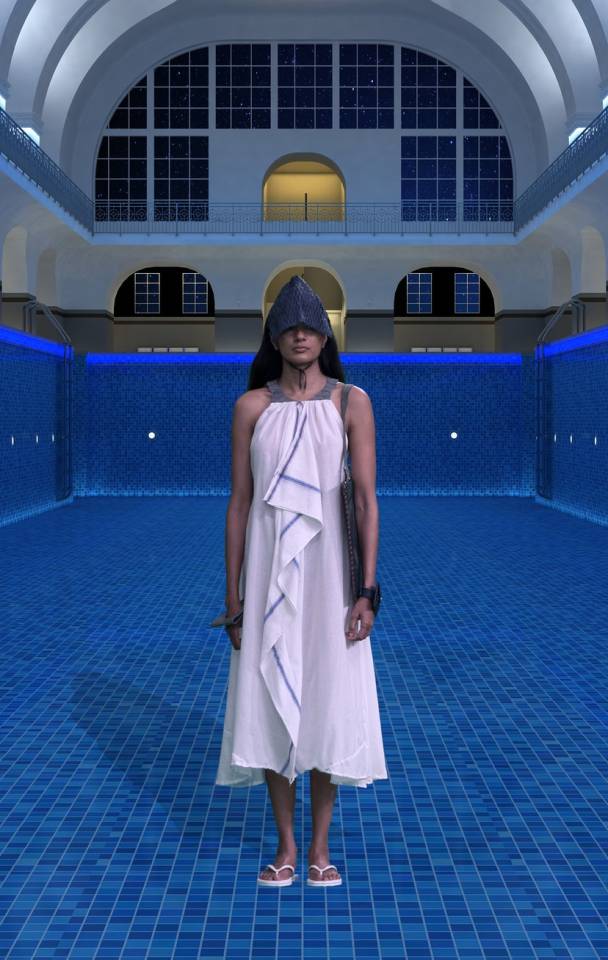
(above: Malai )
Featuring indo-western silhouettes inspired by the culture and sartorial traditions of Kerala (such as the use of traditional mundu fabrics), the collection was minimalistic and clean with the right balance of east meets west. In terms of style, the two looks featured above are definitely my personal favourites.
Moving on to the collection by Pankaj and Nidhi entitled ‘Talisman’, almost every look was a personal favorite, each one more gorgeous than the next.
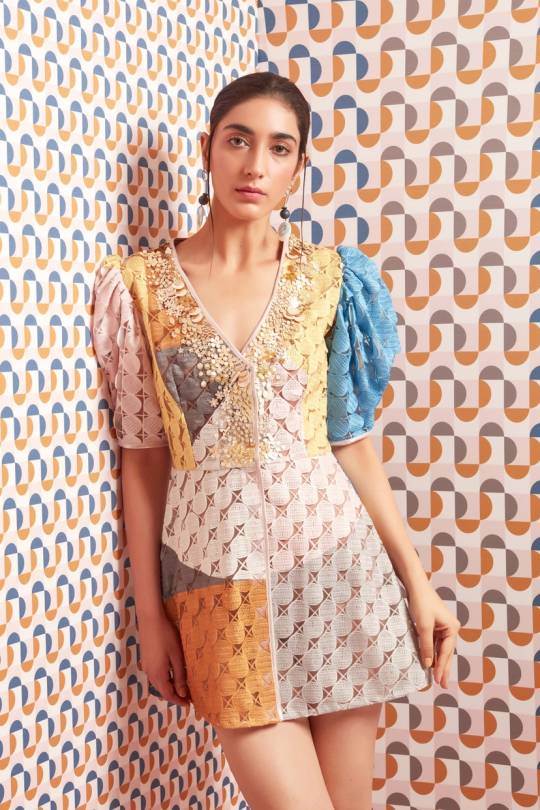
(Above: ‘Talisman’ by Pankaj and Nidhi)
What’s more, the collection was made entirely of fabrics such as ‘GreenGold’ made from 100 per cent recycled plastic PET bottles,’FeelFresh’, a fabric featuring anti-microbial properties and ‘KoolTex’, which absorbs perspiration, together with chiffons and knits. The pleasant color palette combined with the fresh and easy silhouettes were really a joy to behold.
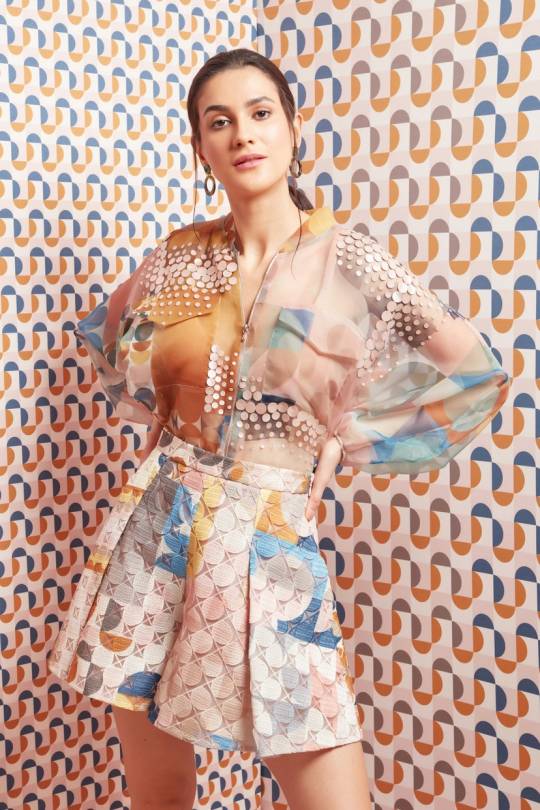
(above: ‘Talisman’ by Pankaj and Nidhi)
Though the use of (recycled) plastic based fabrics don’t completely solve the sustainability issue--it is still a significant step towards the right direction--and the collection clearly proved steps toward sustainability doesn’t mean compromising on aesthetics with the gorgeous sheers, play of geometric shapes, colors and embellishments.
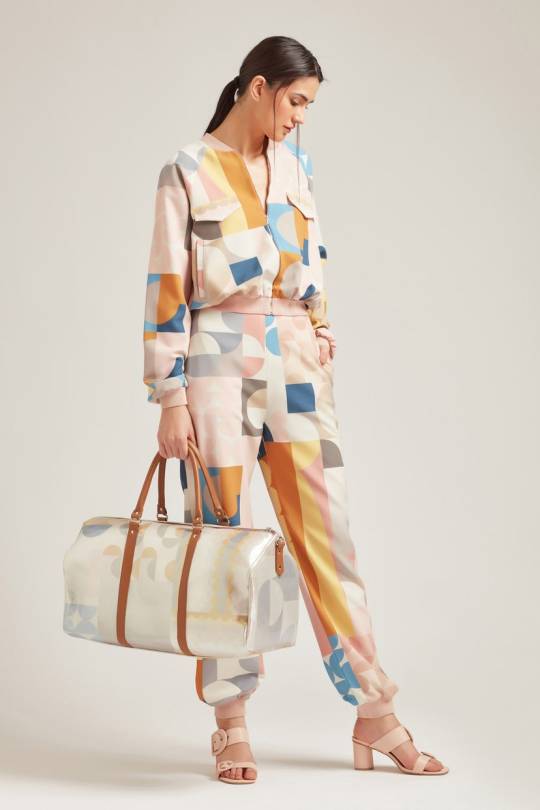
(Above:’Talisman’ by Pankaj and Nidhi)
The busy prints seem to be perfectly balanced by the calming colors, and the collection, in my opinion, gives off a 70s vibe be it in the choice of patterns, the silhouettes, or even the geometric wallpaper that serves as the backdrop.
Presenting an over-all easy and relaxed mood, the collection seems to give one a serious case of wanderlust. (One can only dream, in present times!).
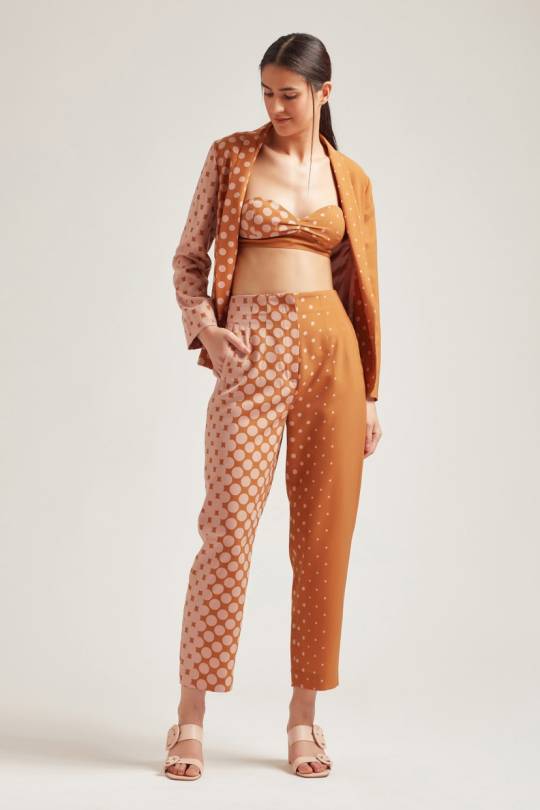
(Above: ‘Talisman’ by Pankaj and Nidhi)

(Above: ‘Taramati’ by Gaurang Shah)
Next comes this gorgeous, gorgeous (did i say that already?) Sari from the collection, ‘Taramati’, where desiger Gaurang Shah brings us to the Golconda era with heritage pieces marvelously incorporating different kinds of traditional weaves and embroidery techniques from all across the country!
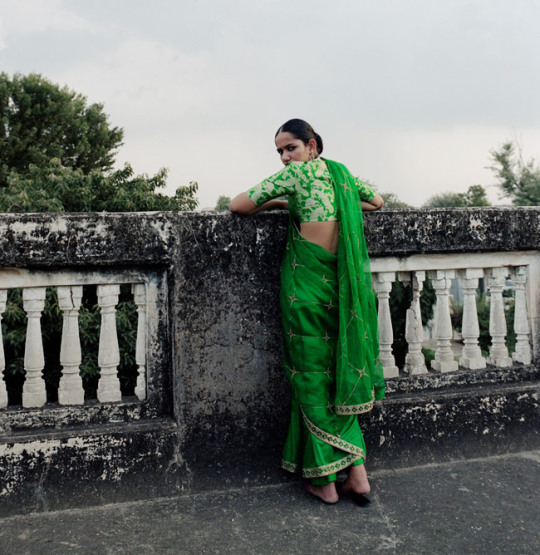
(Above: Moomal by Raw Mango)
Heading to Raw Mango’s nostalgia-infused collection ‘Moomal’, the collection seeks inspiration from designer Sanjay Garg’s home of Rajasthan.
Incorporating traditional Rajasthani silhouettes, cuts, motifs and art forms ( such as Gota embroidery and Bandhej textiles), the bold color combinations, folk influences and comfortable yet luxurious silhouettes really stood out in this collection.
A few favorites from the collection are pictured below.




(Above: All ‘Moomal’ by Raw Mango)
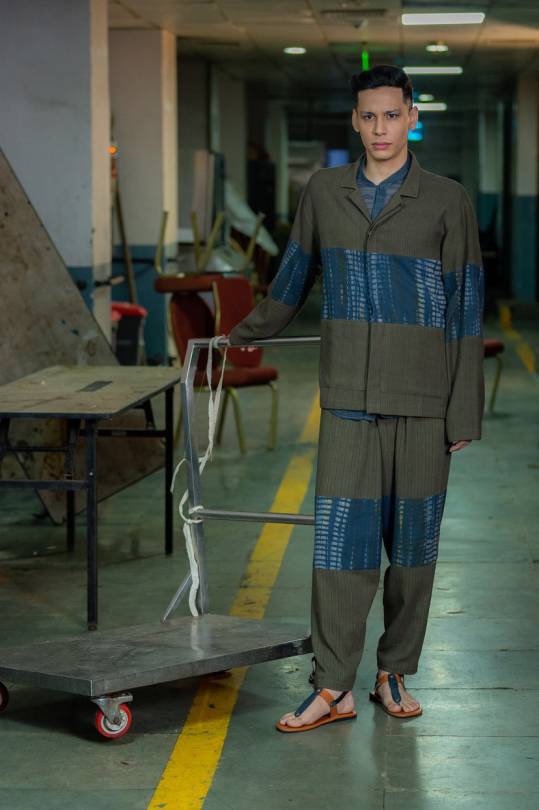
(Above: ‘Tahul’ by Urvashi Kaur)
Heading to this ensemble by Gen-next designer Urvashi Kaur, this easy and relaxed look featuring indigo shibori tie-and-dye combined with the sombre grey was a personal favourite.


(Above: both ‘Between the lines’ by The Loom Art)
The loom art by designer Arushi Kilawat also left an impression with the collection, ‘Between the lines’ featuring fabrics like Chanderi and Matka silk and the Arashi shibori dye technique.
The pleasant pastel colors, boxy and easy silhouettes, and pretty details (such as the oversized bow in the look pictured above) with an overall relaxed vibe make this a winning collection.

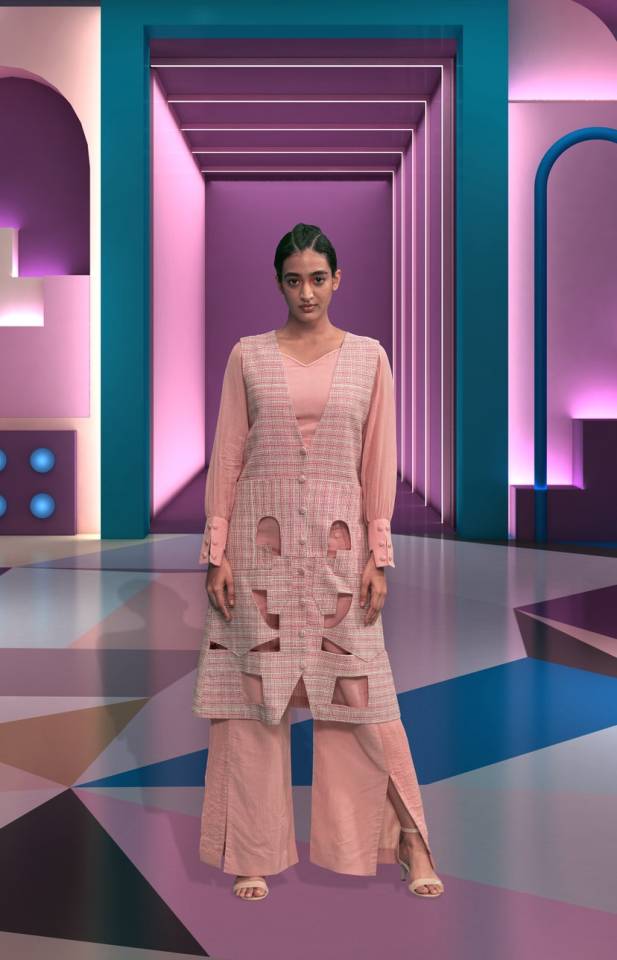
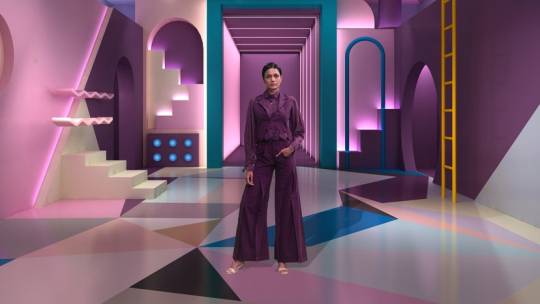
(Above: All ‘Shuwa’ by Mishe)
Winding up this article with another memorable collection, entitled ‘Shuwa’ by Gen-next designer duo Mishe, the collection takes inspiration from the word Shuwa (meaning ‘sign language’ in Japanese) to create silhouettes with unique cuts and elements inspired by sign language.In addition to the unique cuts used as embellishments, the comfortable silhouettes which make the ensembles extremely wearable and the use of pretty tones of pink, deep purple and pure white make the collection a complete treat.
#lakmé fashion week 2020#indianfashion#fashion#fashionweek#fashion2020#sari#shibori#manishmalhotra#mishe#rawmango#sanjaygarg#fashionblog#fashionblogger#fashionblogpost#fashionblogstyle#fashionblogdaily#fashionhistory#fashion archive#silhouette#draping#embroidery#luxury#weaves#indiantextiles#sustainability#sustainable fashion#malai#gaurang shah#pankaj and nidhi#theloomart
0 notes
Text
Essence of Fashion
Thus, it can be said that ‘Fashion’ is a much wider concept while 'Clothing’ is merely, but majorly a part of it.
.
.
(3/3) by Asmitha Shenoy
So, what does fashion really mean and what constitutes it? Is there really a right or wrong way to perceive it? When we, as individuals think of the term ‘fashion’, a lot of different images come to mind: perhaps glamorous models sashaying down runways in designer fashion weeks, a particular look or outfit worn by our favorite celebrities on the red carpet or an iconic movie, a designer’s atelier, swanky branded stores….
What fashion means to a particular person depends largely on their perception of it, shaped by various factors such as exposure and experiences, their environment, culture they belong to, personality, etc. As stated before, one may even notice our perception of fashion evolve over time.
It is interesting to note the various influences across various stages of life and the role it plays on shaping an individual’s perception of fashion, or the various “phases” one goes through. These influences may even have no direct connection with clothing!
Taking myself as an example, my earliest exposure to “fashion” would be the clothes I would see my favorite childhood characters wear, and the most ideal look would be anything pink, anything sparkly, and very importantly, anything a “Barbie girl” would wear.
As I grew out of my Barbie phase and entered my teens, it was shaped mostly by mainstream fashion trends, celebrity style, and whatever Miley Cyrus would’ve approved of in the golden era of Disney Channel.
Fast-forward to present day, Fashion to me is more about self-expression, and also about conscious choices. It is still influenced by celebrities that I admire, it is also shaped by the subcultures, ideas and eras I resonate with, and is heavily influenced by the pop culture that I consume: Movies, Music, books, art.
But it is also a lot about ‘conscious choices’, Making clothing choices that are more sustainable (Through thrifting and upcycling) because to me, Fashion is more than just manufactured trends and fast fashion. It is about slowing down, and paying deeper attention to what we wear, what it means and why we wear it.
This concludes our series on the “essence of fashion”. So, What does fashion mean to you? What do you think Fashion would mean tomorrow? Feel free to drop your comments below!
2 notes
·
View notes
Text
Conte de Vogue- The 20 year rule in fashion
Author: Asmitha Shenoy
Fashion, as we’ve seen from the previous posts, is not linear but cyclical, with new trends emerging every season often borrowing heavily on nostalgia and trends of the past, with modern twists and innovation. This influence of past trends can also be seen on pop culture like music, movies, décor, arts,etc. So it may come no surprise how current fashion trends have been reminiscent of 60s/70s/80s and 90s fashion along with the y2k fashion trends of the early 2000s.
This phenomenon of trends coming back every couple years is termed as the “20 year rule” by fashion insiders, according to which fashion trends come back every 20 years. Remember the kind of clothing you saw your parents wearing in old photo albums and you probably found tacky as a child? They’re probably influencing runways and street style, and possibly your own wardrobe.

Applying this rule to 2020 fashion trends, it should come as no surprise then, that the y2k aesthetic is everywhere. For the generations born during the early 2000s, we may probably recognize a lot of the influences as being a part of our childhood, and it may either bring back nightmares of tacky clothing choices we vowed never to make again as we looked at our childhood selves in those polo t-shirts, butterfly hairclips, and gummy sandals; or (in most cases) bring back the comfort of nostalgia, and somehow find it really charming and really fashionable again.
So the real question is,How does this 20- year rule come into play?
Fashions from the past eras are often a source of inspiration for designers and a starting point for designing their collections. Prestigious fashion houses also look back into their archives bringing back iconic looks with a fresh perspective, still keeping the values of the brand intact. These fashion trends are often spread through celebrities, or influencers and shared and reblogged on social media at a very fast pace.
Often, there’s a sense of comfort looking back at the past due to the familiarity and comfort associated with it, which makes nostalgia so appealing, perhaps, now more than ever, with the uncertainty of the future looming before us. Y2k fashion, having emerged in a period of technological prosperity of the 2000s, being bold, ornamental and futuristic, may be just what we need as we enter a new era.
Though it is quite ironic that the y2k trend that was driven by luxurious consumption and globalization and characterized by heavy use of designer brand logos and fast fashion and mass-consumerism is making a comeback in times of a global pandemic where these very cycles have been disrupted and sustainable, slow fashion is the buzz of the day, one can find numerous consumers accessing y2k trends through purchasing authentic, thrifted clothing of the era, which wonderfully shows how trends can be accessed in a conscious manner.
So what’s going to shape the future of fashion in the next 20 years? Perhaps it may not be much of a surprise after all.
Resources on Y2K fashion trends in 2020:
https://www.preview.ph/fashion/capsule-wardrobe-y2k-aesthetic-a00358-20200905
https://www.collegefashion.net/trends/y2k-fashion/
1 note
·
View note
Text
Influence of Music on Fashion
Author: Asmitha Shenoy
In the last two posts, we’ve explored how music can influence fashion in various ways. As a conclusion to this series, we’re going to look at one of the most iconic piece of clothing of our times that is also probably the most visible example of the influence music plays on clothing: Band T-shirts!
Band Tee Shirts. Think Nirvana or Pink Floyd. You’ve probably seen them as a part of street style, you’ve probably seen celebrities wearing them, and they often feature in the clothing racks of high street fashion brands. Band T-shirts, in recent times have become so ubiquitous with fashion trends that one would often come across people sporting t-shirts of bands that they probably don’t listen to, possibly enraging or amusing fans of the band in question.
So what is it about band t-shirts that makes one look instantly “cool” and has enthralled fashion and street style enthusiasts? How did icons of particular music groups become the mainstream and why do so many resonate with it?
Band T- shirts first emerged as promotional tools for bands (often associated with a concert tour) which would be sold at their tours, shows and events. The practice of releasing concert t-shirts is associated with the 1960s, when printed T-shirts gained popularity for self-expression as well for advertisements, protests, and souvenirs. In 1968, rock producer Bill Graham co-founded Winterland Productions, often touted as the “first concert t-shirt manufacturing company”. Initially limited to being concert memorabilia for passionate fans, limited edition band t-shirts quickly shifted to being a high-end street style trend where “official merchandise” of a particular band became more than just an item for a select niche group, and became an iconic fashion item.
The revival of band t-shirts of retro rock bands from the 60s and 70s is also linked with an increased interest in music of that era among the current generation. Band T-shirts can either act as a cultural signifier and a mode of self-expression where one feels a sense of prestige wearing a t-shirt of their favourite band, but can also epitomize a “cool, laid-back and edgy” look for others interested purely on the aesthetics of the design. Today, the potential of a t-shirt representing a musical act has risen to such an extent that most artists release “official merchandise” associated with a new album release that spans clothing and accessories, and in current times, even face masks!
Whatever one’s reason may be to sport a band t-shirt, one thing’s for certain, Fashion is hooked!
Do you own any band t-shirts? What’s your take on the band t-shirt trend? Comment below!

(P.S- Here’s an interesting article on the types of Band t-shirts that are considered trendy:
https://blog.printsome.com/band-t-shirt-debate/ )
1 note
·
View note
Text
MOODS & MUSES: ANDY WARHOL AND MODERN FASHION
Kick-starting a brand new series on fashion and the fascinating inspirations and concepts that guide fashion creatives, Moda Factor brings to you “moods and muses” where we take a deeper look at iconic muses and themes that inspire and influence fashion– season after season, time and again and the prominence that it holds in current times, and what it could mean tomorrow.
Author: Asmitha Shenoy
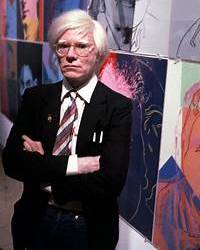
Andy Warhol is no stranger to many who are well-versed in fashion and art. The iconic Campbell Soup paper dress printed by Warhol in the 60s permanently enshrined him in the world of fashion, as his legacy continues to inspire designers even today.
A leading figure in the visual arts movement of Pop art, he began his career as a fashion Illustrator for Harper’s Bazaar, where he was reportedly called ‘Andy Paper bag’ by then-fashion editor Diana Vreeland because of the way he brought his illustrations into the office.
Entering the art scene with his first solo show in 1962, His use of imagery from popular and mass cultures such as cultural objects, celebrities, comic books, and advertising greatly influenced the fashion world, solidifying his prominence in the industry forever.
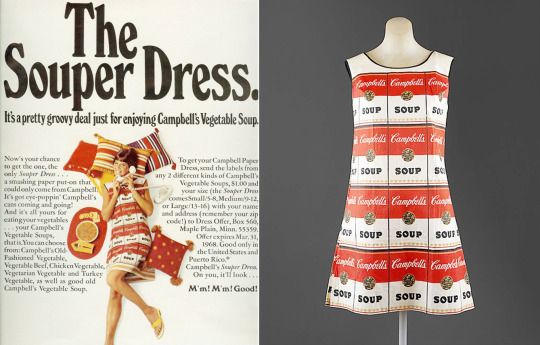
Fashion inspired by Warhol, initially featuring only in paper dresses called “Souper Dresses”, soon featured in high fashion runways of designers such as Jean Charles de Castelbajac, who included a dress shaped and printed like a Campbell’s soup can in his Spring/Summer 1984 collection.
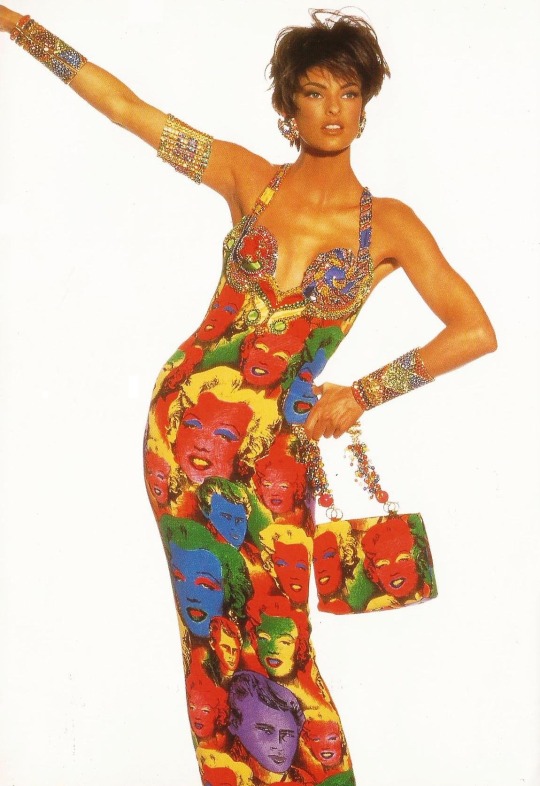
This was followed by Versace in 1991, where they released a jewel-encrusted gown modelled by supermodel Linda Evangelista featuring Warhol’s iconic depiction of Marilyn Monroe.
Since then being a regular feature in the fashion world, one often sees high-fashion reproductions of Andy Warhol’s works featuring in t-shirts, accessories and clothing.
Warhol’s style and focus on consumerism and pop culture in his art continues to be a major influence on fashion designers even today, which can be seen in the work of Jeremy Scott, both in his eponymous label and his designs for Moschino, such as his sequined dress and top featuring a logo referencing the classic Coca-Cola symbol in his A/W 2011 line, and the Spring 2013 Moschino menswear collection that featured pieces with the Budweiser logo and that of a detergent company. And none can forget Moschino’s 2014 A/W Womenswear RTW collection that featured looks inspired by and featuring the McDonald’s logo, packaging of various food brands such as Fruit loops, and SpongeBob, giving a nod to the pop art movement that Warhol was part of.
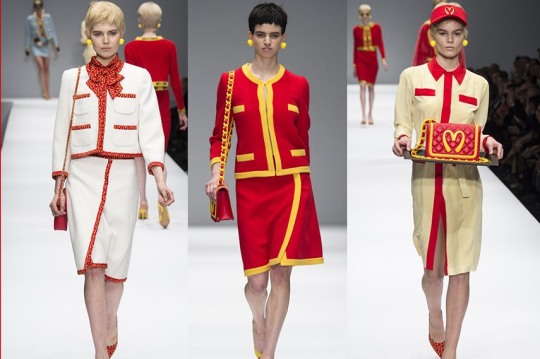
The relevance of Warhol’s works and focus on using pop culture references and unexpected product packaging and graphic design prints and logos can even be seen today, with fast fashion brands emblazoning their clothing with playful and quite ironic logos of cereal brands, for example.
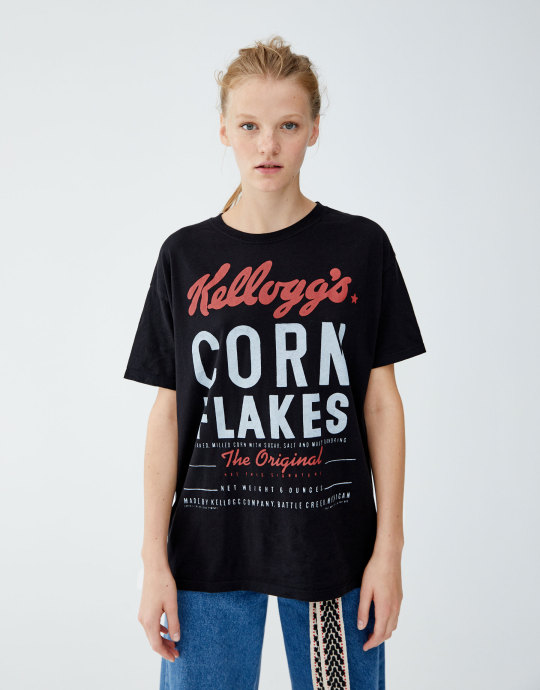

And it doesn’t end there. Vetements, for their spring 2020 menswear line converted Paris’ largest McDonalds outlet into a fashion runway featuring clothing with corporate logos as a sarcastic response to Capitalism. While not a direct pop art reference, the use of logos of consumer brands and mass culture, a feature of pop art, can be seen , and the growing focus on using brand logos as an aesthetic perhaps signifies the sign of the times: fast-paced globalization and a ‘culture’ shaped by mass production. In a time where the world is increasingly aiming to be ‘sustainable’, what significance would it hold in years to come? Is the trend of consumer-brand iconography as a fashion aesthetic an ironic satire of the times we live in? What appeal does it hold for us, as fashion consumers? An intrinsic and easily identifiable part of global culture, pop art in design seems to be a common design inspiration and the various connotations it could hold in changing times, in addition to the various meanings designers attach to it as a tool of expression in fashion collections, continues to be interesting to observe.
27 notes
·
View notes
Text
MOODS & MUSES: COCO CHANEL, Icon de la mode
Continuing with our series on fashion and the fascinating inspirations and concepts that guide fashion creatives, Moda Factor brings to you “moods and muses” where we take a deeper look at iconic muses and themes that inspire and influence fashion– season after season, time and again and the prominence that it holds in current times, and what it could mean tomorrow.
As the french fashion house CHANEL unveils an exhibition entitled “Gabrielle Chanel Fashion manifesto” at the Palais Galleria in Paris ( which runs till March 14, 2021), A ‘retrsopective recounting the early beginnings of the couturiere with a few emblamatic creations which defied the prevailing fashion of the times’; in this edition of ‘Moods & Muses’, Moda Factor takes a look at Coco Chanel the legendary fashion designer, as Chanel: the fashion icon,and how she has enshrined herself as an enternal muse to fashion creatives and fashion enthusiasts alike.
Author: Asmitha Shenoy

“Fashion fades, only style remains the same.” said Gabrielle Bonheur “Coco” Chanel. Creator and propagator of iconic designs and styles such as her iconic faux pearls, 2.55 quilted bag, the Chanel tweed suit, the breton top and the little black dress to name a few, Chanel is equally known for her unique and impeccable personal sense of style.
“ That’s so Chanel!” one would exclaim, glancing at an ensemble consisting of a little black jersey dress, a string of pearls, a pillbox hat and a classy pair of heels.
Perhaps one of the most significant influences on modern day “Parisienne look” and aesthetic, her personal style was elegant, comfortable and simple.
“Simplicity is the keynote of elegance”, as she is famously known to have said.
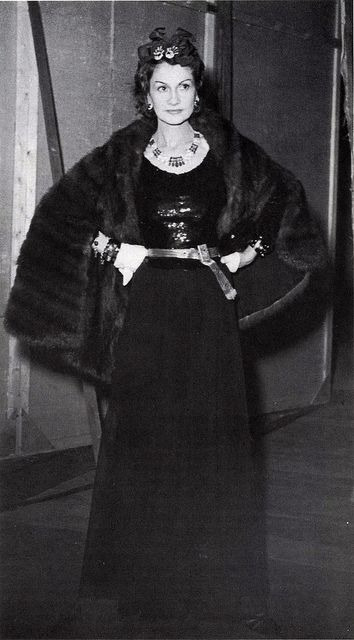
She often stuck to black and white as colors and she preferred color blocking with these colors. Other style elements she often incorporated in her style includes nautical stripes, and the functionality of menswear transformed into elegant womenswear, keeping the feminity of womens’ clothing intact. An example of this are wide legged pants that she often wore paired with espadrilles in the summer. This iconic combination has long since become forever enshrined as “French girl chic”

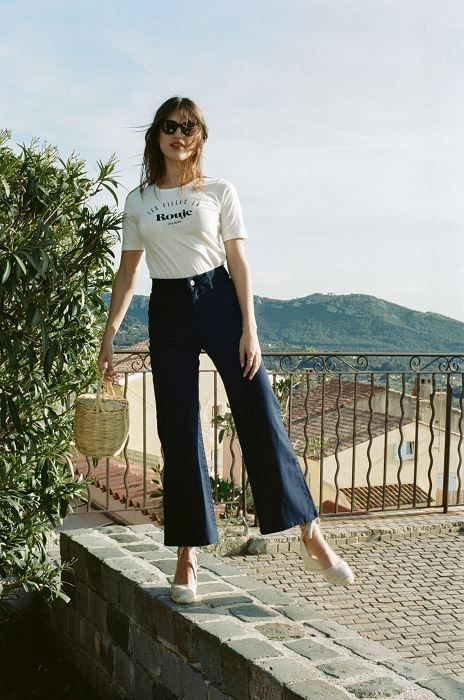
Known to have said “Fashion is architecture, it is a matter of proportions”, she was instrumental in popularising the tweed suit, and the legendary Chanel suit that has inspired many designers and fast fashion copies alike. The design house,to this day recreates variations of emblematic chanel codes, and the suit remains one of the most popular and identifiable styles.

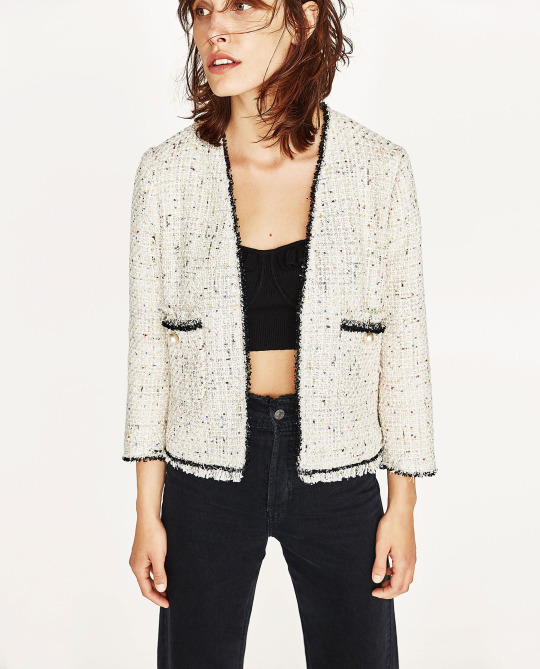
above: A high-street brand appropriation of the Chanel jacket
Also a proponent of Jersey fabric, Chanel popularised knits amongst high society by incorporating them into her elegant silhouettes. Moreover, she was a fan of statement jewellery pieces, accessorising her looks with her famous string of pearls, as well as studs and rings.
And who could forget the signature fragrance Chanel no.5, which is still one of the biggest-selling fragrances in the world to this day?
Today, Madamoiselle Coco Chanel’s legacy is still alive, often serving as the face of fashion and one of the biggest inspirations for starry-eyed girls and boys alike, who grow up dreaming of following her footsteps to enter the glamorous world of fashion, a dream propogated by the enchantment of Chanel.
To many, the word ‘Fashion’ begins with a C instead of an F as ‘you can’t spell Fashion without Chanel!’. Humour aside, Chanel is a major inspiration to fashion designers, bloggers, influencers and enthusiasts alike.
Drawing a dedicated fan-following spanning step-by-step ‘How to dress Chanel on a budget’ blogposts (Including a post on wikihow!) and videos, and aesthetic mood boards on Pinterest, WeHeartIt and Tumblr alike, the Chanel life style has inspired many, not limited to designers concept boards and look books of fashion bloggers.

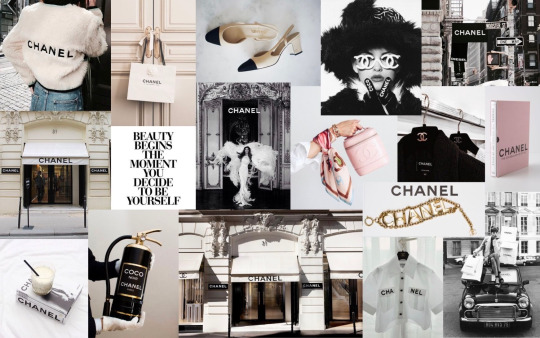
The Chanel logo is also often appropriated on consumer-brand products featuring clever graphic design imagery inspired by the iconic logo as well as the designer herself, featuring on products such as—and not limited to—phone cases, notebooks and other stationery, and acessories, quite ironically solidifying Coco Chanel’s prominence in modern pop culture.
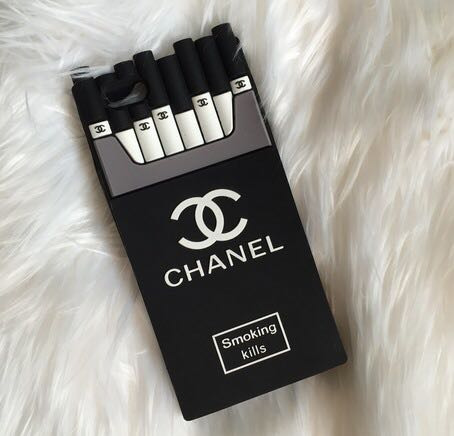
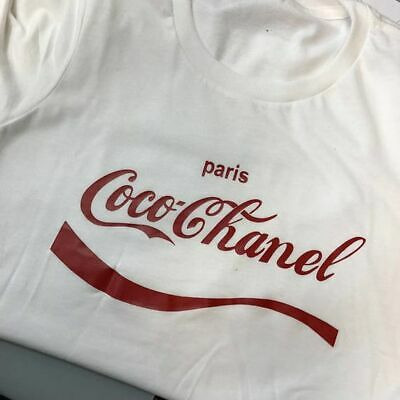
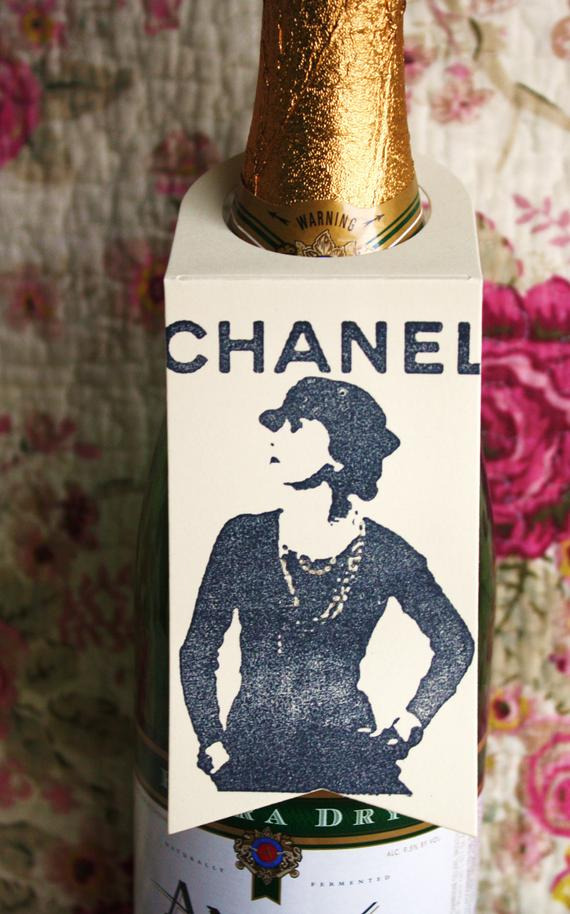

Her name and brand,a symbol of class, elegance and exclusivity, have now become so synonymous with high fashion, haute couture and luxury that it is hard to imagine one without the other.
Such is the allure of Coco Chanel.

(For more on the legacy of Coco Chanel, who ‘ closed one era and launched a new century of fashion.’, we recommend following the design house’s inspiring series, ‘Inside CHANEL’ on youtube.
You can view the entire series here.)
1 note
·
View note
Text
An article I’d written for the blog. Do check them out!
Indigenous Inspirations: The Kaba dress
Presenting a new series, ‘Indigenous Inspirations’ where we explore the rich sartorial traditions and textile art forms of diverse countries and cultures.
In the wake of the current global scenario, it is important,more than ever, to promote and reclaim the power back to cultures that deserve to be preserved and appreciated, to bring the spotlight back to the richness and beauty of these cultures, including their clothing history.
Keeping that in mind, In the first edition of Indigenous Inspirations, We take a look at the Kaba, a beautiful dress worn by the women of Cameroon, In Central Africa.
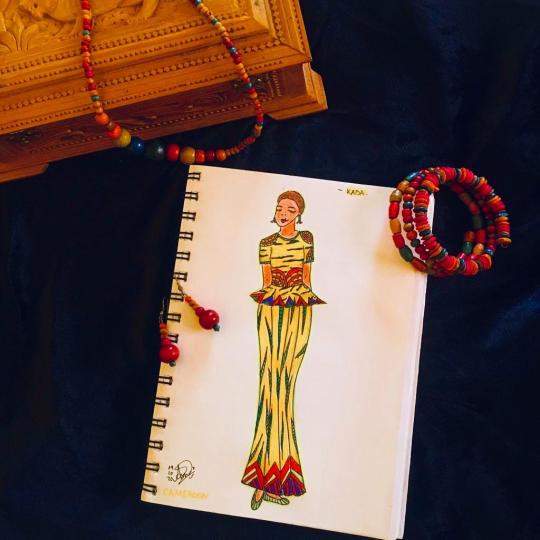
Above: An artistic rendition of a modern interpretation of Kaba partly based on the writer’s memory
I have a personal story associated with how I first came across this beautiful garment. Noticing an exchange student walk past in a beautiful and colorful garment i didn’t know the name of, It was also the silhouette, which looking at from afar, consisted of a gored skirt and (If I recollect correctly) A top reminscent of a peplum silhouette. Being a fashion student at the time, I walked up to her and complimented her on her beautiful traditional dress and asked her about the same. “It’s called a Kaba”, She said, and up close, the combination of the colors yellow, red, blue, green, seemed to match perfectly with her beautiful and smooth ebony skin, accessorised with simple, colorful beaded earrings.
A quick google search after this conversation on ‘ Kaba’ and ‘Cameroon’ provided with very little written information, but a substancial amount of Caba images, consisting of various silhouettes and prints.
Here is a compilation of those pictures and some information on the beautiful garment, that is the Kaba.
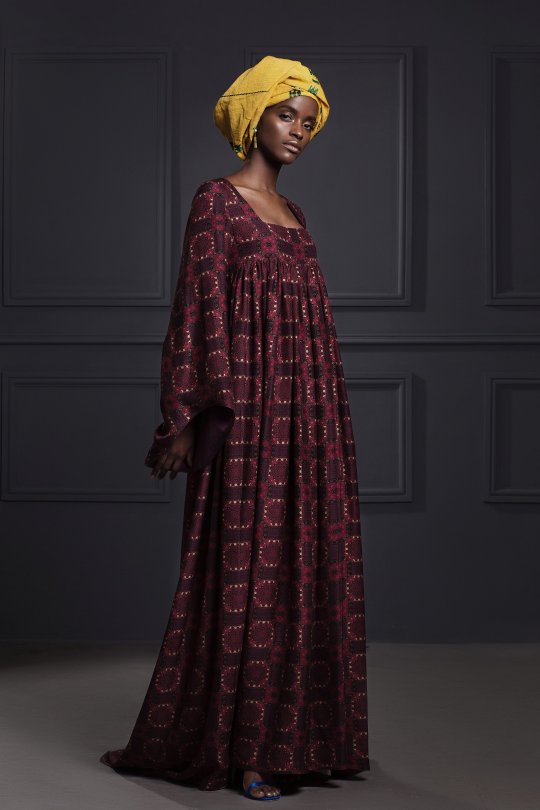
The Kaba, is a maxi dress with a yoke, extending from above the bust, worn by the Sawa women of Cameroon. While the authentic kaba is usually a maxi dress, most women tend to call any loose fitted dress sewn with Batik or Wax visco fabric as a Kaba.
The Kaba is thought to have been created by Hélène Saker, the wife of missionary Alfred Saker, to ‘ cover the naked bodies of her husband’s servants, and make them presentable before God and missionaries, such as her husband.’
Certain sources, however, seem to claim that the Kaba is purely of Cameroonian conception and origin.
Regardless, According to Cameroon Gallery, the Kaba created by Hélène had no glamour or beauty, and resembled a ‘large bag’ consisting of 4 openings: 2 sleeves, and one opening each for the head and feet.
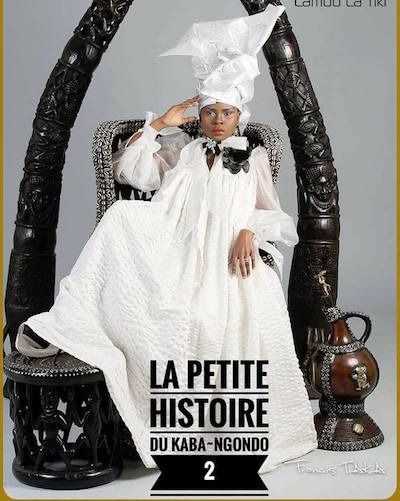
As the Kaba spread beyond the maid-servants and into the daily wardrobe of the women, It underwent many transformations, and the Kaba came to represent the history and culture of the women of the coast of Cameroon, and has also become the outift of choice for the Sawa women during the festival of Ngondo.
The Kaba finds relevance in the present day as the honorary garment of some respected women, such as elders and high-class ladies.
Incorporating various eye-catching prints and stylish modern silhouettes, the modern-day Kaba seems to reflect the changing tastes of modern Cameroonian women, with google search suggestions such as ‘latest kaba styles 2020′.
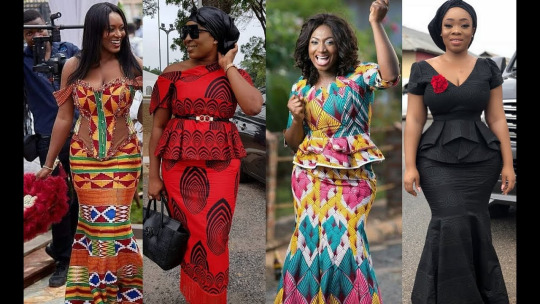
The Kaba and slit silhouette, often worn in Ghana, consists of a blouse and a skirt.
Modern interpretations of Kaba also consist of innovative and eye-catching looks such as the one below.
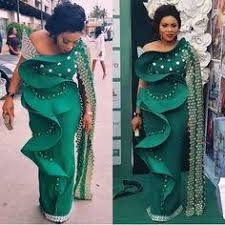
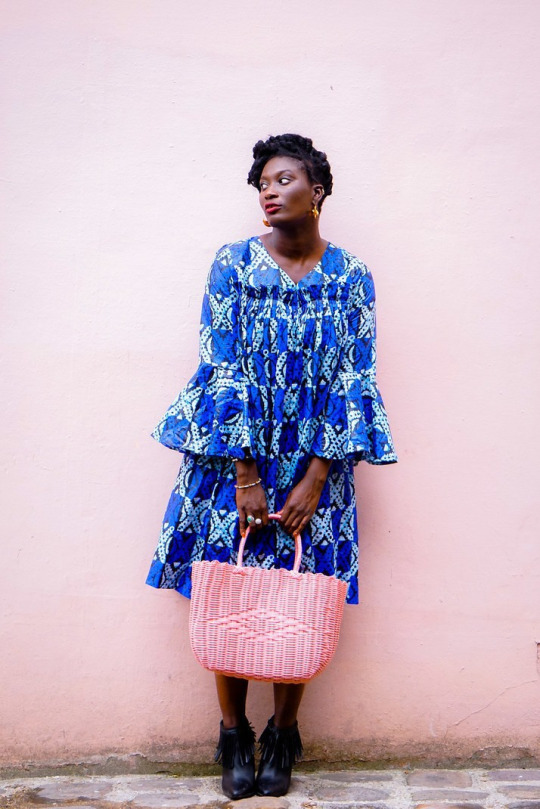

Modern day adaptations inspired by the Kaba into day to day dresses consisting of simple silhouettes, keeping intact the eye-catching prints and colors of the original can also be seen.
In recent times, the Kaba has also inspired young African fashion designers in their collections. One such collection, is ‘Ngondo’, a 2018 Resort Collection hy Maison D’Afie.
(You can read the original blogpost on the collection written by a Nigerian Fashion and lifestyle blog,here.)
The collection,Ngondo, draws inspiration from the Kaba, worn by the Cameroonian women in colonial times. The colors used in the collection also reflect the culture and lifestyle of the Sawa tribe, from where, Sarah Divine-Garba, the creative director of the brand hails from.
The collection re-interprets the style elements of traditional kaba into modern and elegant silhouettes, with numerous alterations to the original silhouette, using techniques such as pleats, and elaborate sleeve styles and rich yet subdued colors of green, and brown, with accents of colors such as yellow and pink, also incorporating prints reminscent of the original Kaba.

One thing that binds the traditional Kaba and it’s modern interpretations, is that it represents the aspirations and rich cultural heritage of the culture it hails from.
A garment that symbolises deep cultural meaning, the future of this beautiful garment,Kaba, seems bright and promising.
5 notes
·
View notes
Text
A piece contributed by me to the blog, moda factor. Do check them out!
Fashion Archival: Millie the Model (1965) issue fashion scans
Millie the Model (1945-1965) was a comic book series by Marvel Comics and first published by the company’s 1940s predecessor, Timely Comics. It was created by Ruth Atkinson,and was written by her, among others, including the legendary comic book writer Stan Lee. Narrating the story of aspiring model Millie, It is a great source of retro 1960s fashion inspiration, the comic often featured designs submitted by their readers. Below are scans from a 1965 issue of the comic showcasing gorgeous gowns, ready to wear, hairstyles, and more!
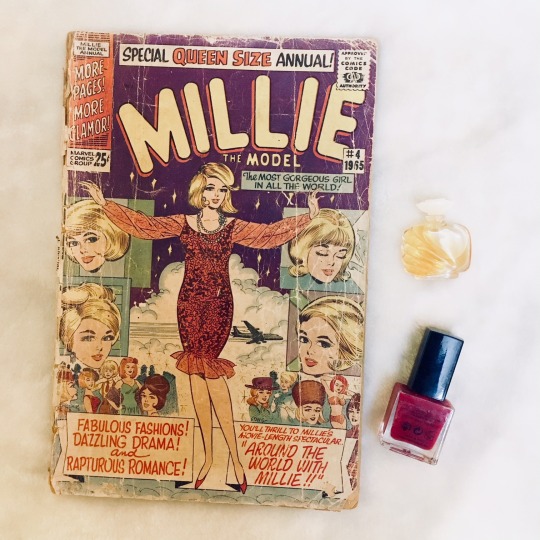
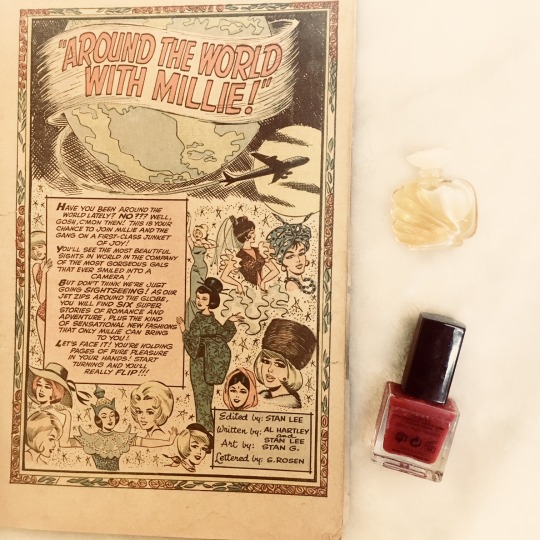
Containing narratives exploding with drama, romance and glamour, the comic provided a quite alluring view into the world of fashion and modelling, Pertaining more to the idea of being a source of entertainment and fantasy to it’s readers.
This particular issue, for example, contained mini-stories of Millie and her colleagues as goodwill ambassadors travelling the world (and providing quite a stereotypical view of various countries and cultures), in stories containing drama, rapture and romance. And fashion, ofcourse.

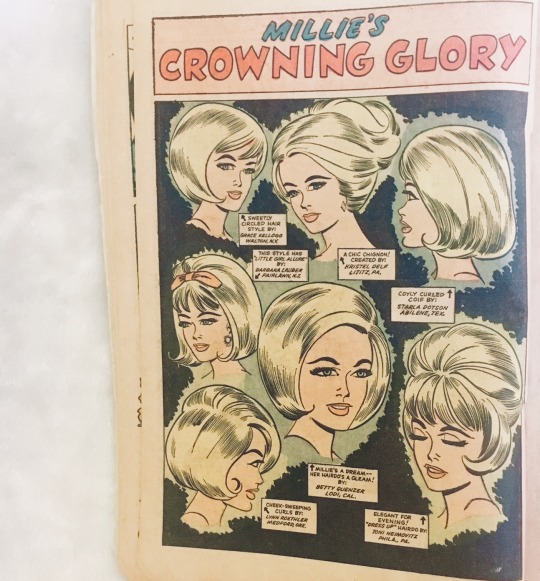
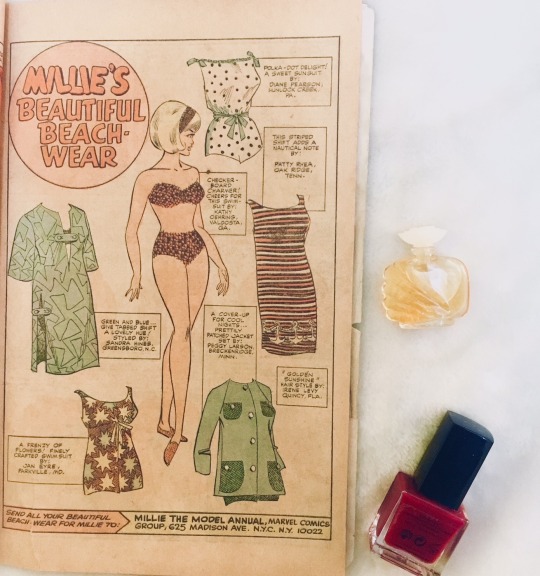
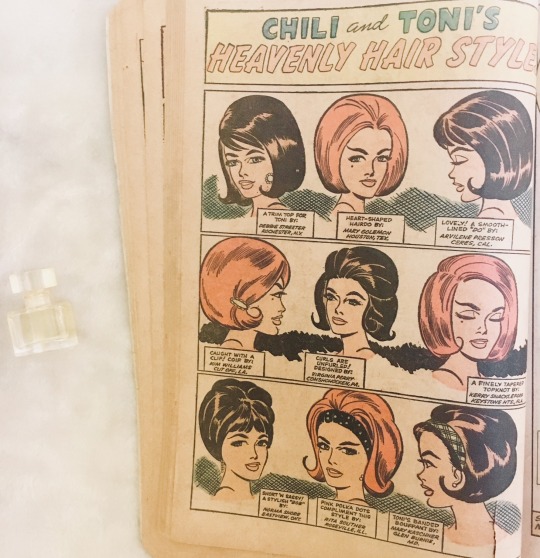
The comic also featured Millie’s colleagues, Models Chili and Toni as supporting characters to the series.
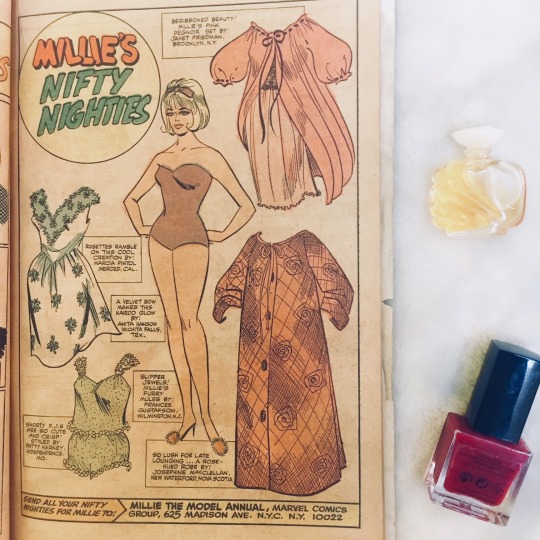
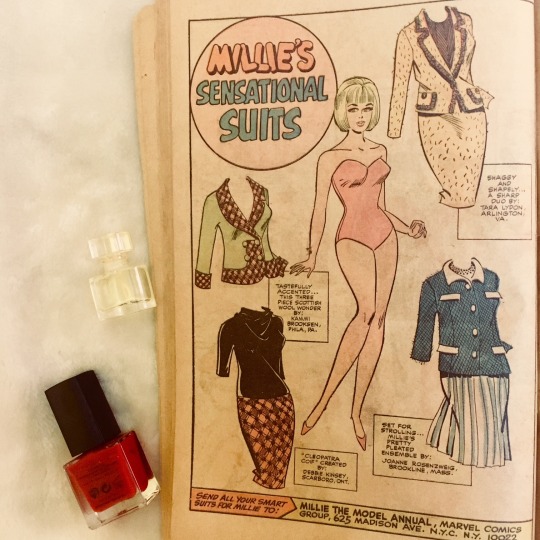

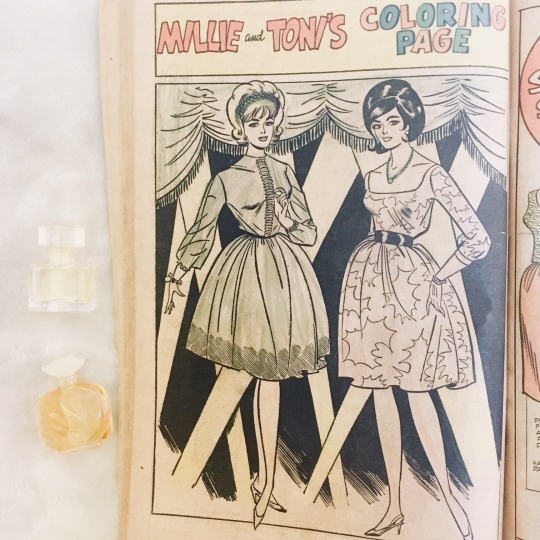
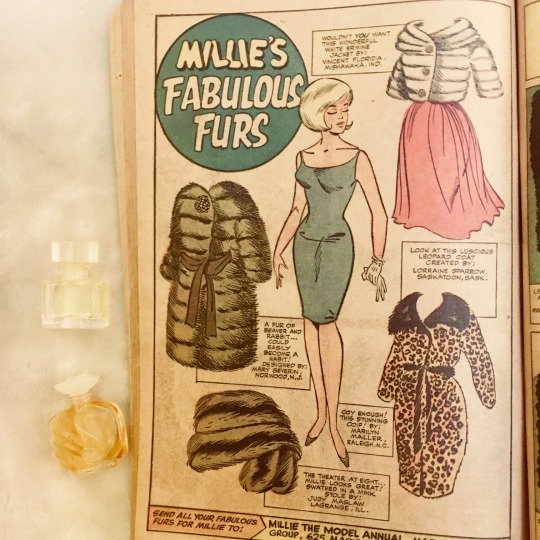
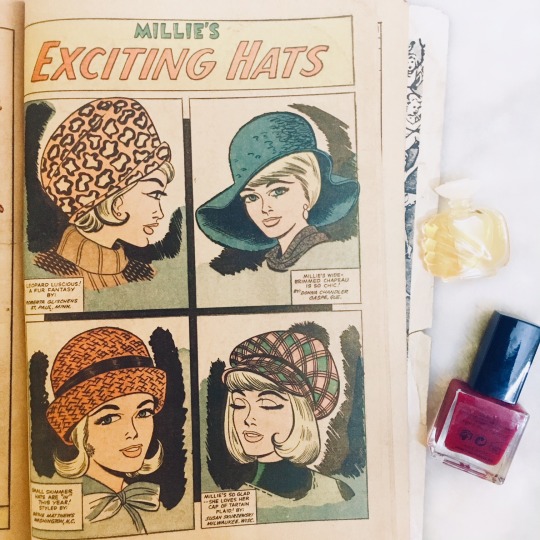
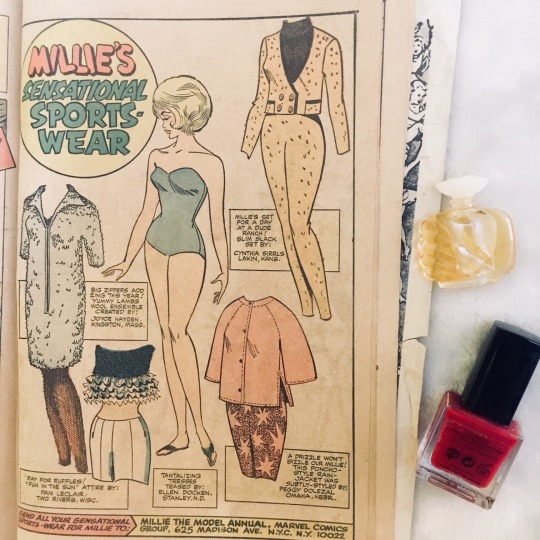

Fuelling the imagination of it’s readers, and possibly young readers of the time aspiring to be a part of the glamorous world of fashion, who would contribute their own fashion design ideas to be featured on their favourite characters, the comic serves as a terstament to the power and appeal of fashion and clothing to entertain,inspire, and resonate with a wide group of people.
As comic books became popular in the 50s and 60s, comics on fashion such as Millie the model, Katy Keene,and others portrayed the fashion trends of the time and made this world more accessible to it’s readers. It is also a wonderful example of the relation between comics and fashion. But that’s another story!
(If you liked this article, you may find this piece by the New York Times on an exhibition on comics and couture, interesting.)
10 notes
·
View notes